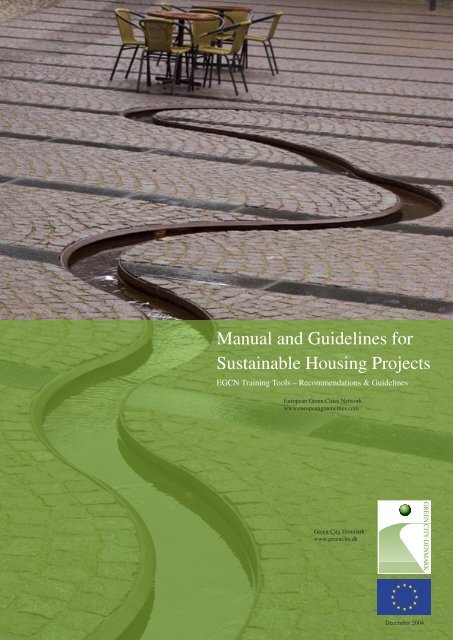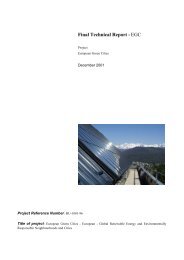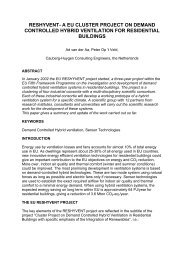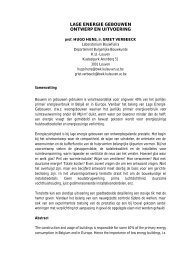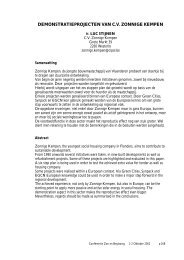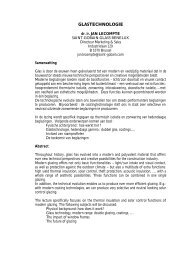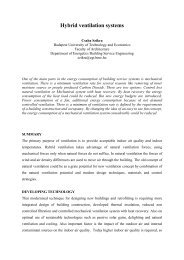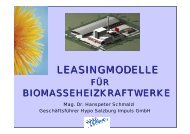Manual and Guidelines for Sustainable Housing Projects
Manual and Guidelines for Sustainable Housing Projects
Manual and Guidelines for Sustainable Housing Projects
Create successful ePaper yourself
Turn your PDF publications into a flip-book with our unique Google optimized e-Paper software.
<strong>Manual</strong> <strong>and</strong> <strong>Guidelines</strong> <strong>for</strong><br />
<strong>Sustainable</strong> <strong>Housing</strong> <strong>Projects</strong><br />
EGCN Training Tools – Recommendations & <strong>Guidelines</strong><br />
European Green Cities Network<br />
www.europeangreencities.com<br />
Green City Denmark<br />
www.greencity.dk<br />
1<br />
December 2004
Contents<br />
Introduction<br />
Environmental impacts of housing projects<br />
Environmental management in project design<br />
<strong>Manual</strong> <strong>and</strong> guidelines<br />
1. Site conditions<br />
2. Development plan<br />
3. Planning the building etc.<br />
4. General design of the building<br />
5. Building materials<br />
6. Indoor climate<br />
7. Energy consumption in buildings<br />
8. Water consumption in buildings<br />
9. Waste <strong>and</strong> waste removal<br />
10. The outdoor areas<br />
Labelling housing projects<br />
Literature <strong>and</strong> links<br />
(<strong>Manual</strong> <strong>and</strong> <strong>Guidelines</strong> <strong>for</strong> <strong>Sustainable</strong> <strong>Housing</strong> Projekts<br />
is developed as part af seversl other developed EGCN Training Tools<br />
- see www.europeangreencities.com)<br />
European Green Cities Network<br />
EGCN is a thematic network funded by the EU with the aim of<br />
marketing applied technologies in sustainable housing projects<br />
<strong>and</strong> advancing new solutions within this field.<br />
EGCN derives from the European Green Cities, Green <strong>Housing</strong><br />
Block <strong>and</strong> the Green Solar Region projects. Demo projects can be<br />
seen on: www.europeangreencities.com<br />
The partners are:<br />
Austria: GSWB, Salzburg. SIR, Salzburg, Salzburg City.<br />
Belgium: Provincie Antwerpen. VITO, Mol. Zonnige Kempen, Westerlo.<br />
Chech Republic: Ventos, Rumburk, Decin City.<br />
Denmark: Cenergia Energy Consultants. City of Copenhagen.<br />
Fællesbo (<strong>Housing</strong> Association). Green City Denmark A/S.<br />
Municipality of Herning. Municipality of Glostrup. Municipality<br />
of Roskilde. Rambøll. SBS By<strong>for</strong>nyelse. Solar Vent.<br />
Finl<strong>and</strong>: City of Kuopio.<br />
France: Municipality of Echirolles. OPAC38, Grenoble.<br />
Greece: Demekav, Volos Municipality, CRES.<br />
Hungary: EMI, Budapest, Ujpest Municipality.<br />
Italy: ALER of Brescia. ATC Torino. ATER L’Aquila. City of Brescia.<br />
Metec & Saggese Engineering Srl. Regione Abruzzo, L’Aquila, City<br />
of Torino.<br />
Lithuania: UAB Namu Prieziuros Centras (NPC).<br />
Pol<strong>and</strong>: National Energy Conservation Agency, Piaseczno<br />
Municipality.<br />
Spain: Ajuntament de Vilanova i la Geltrú. Institut Cerdá,<br />
Barcelona. Qualitat Promocions SCCL, Vilanova i la Geltrú.<br />
UK: Merz Orchard, London. Portsmouth City Council.<br />
2<br />
Green City Denmark<br />
Green City Denmark is Denmark’s national <strong>and</strong> international<br />
showcase <strong>for</strong> energy <strong>and</strong> environmental solutions. Green City<br />
Denmark is organized as a limited liability company with more<br />
than 250 shareholders - companies, municipalities, counties, <strong>and</strong><br />
institutions etc. from all over Denmark, along with an international<br />
network of public <strong>and</strong> private sector partners.<br />
The main purpose is to market Danish expertise within the field of<br />
environmentally sound production <strong>and</strong> sustainable solutions.<br />
Our environmental <strong>for</strong>um includes:<br />
• Technical visits to interesting Danish best practice facilities,<br />
companies, central <strong>and</strong> local authorities, etc.<br />
• Export missions to selected markets with the aim of promot-<br />
ing Danish technology <strong>and</strong> know-how.<br />
• Training activities – transfer of know-how <strong>and</strong> technology.<br />
• International project co-operation <strong>and</strong> financing.<br />
• Contribution to environmental seminars, conferences, <strong>and</strong><br />
workshops.<br />
• Task <strong>for</strong>ces.<br />
• Joint ventures.<br />
Produced <strong>for</strong> Green City Denmark A/S by GBL Gruppen <strong>for</strong> by &<br />
l<strong>and</strong>skabsplanlægning aps. (Town <strong>and</strong> L<strong>and</strong>scape Planning Group),<br />
Pakhustorvet 4, DK-6000 Kolding, Denmark. Phone +45 7552 6444.<br />
www.gbl.dk. Revised 2005.
Introduction<br />
The purpose of this manual<br />
Green City Denmark would like to offer our partners in EGCN<br />
a useful tool, suitable <strong>for</strong> environmental management in housing<br />
projects.<br />
The object is clear. All over the world the environment is under<br />
intense pressure. One of the reasons being that the built environment,<br />
both during construction <strong>and</strong> when being maintained, consumes<br />
an enormous amount of resources causing significant effects<br />
on the environment.<br />
During the project design phase, it is possible to act with greater<br />
or less wisdom in relation to the environment. The decisions made<br />
here are crucial to the results. However, to reach the best result it<br />
is necessary to work systematically <strong>and</strong> to develop a sound working<br />
knowledge of the requirements.<br />
This manual is intended to serve as a basic tool in this process.<br />
The manual is equally relevant to clients, architects, engineers <strong>and</strong><br />
authorities.<br />
How to use this manual<br />
The manual <strong>and</strong> guidelines provide a checklist <strong>for</strong> use when dealing<br />
with sustainable housing projects <strong>and</strong> related works.<br />
First, you will find a couple of general sections on the issues,<br />
explaining the environmental impact from housing projects, <strong>and</strong><br />
explaining the suggested method of environmental management in<br />
project design. Then you will find steps A, B <strong>and</strong> C <strong>for</strong> the design<br />
process. Finally you will find a section on labelling housing projects.<br />
An appendix provides relevant literature <strong>and</strong> web links.<br />
The central parts of the manual – A, B <strong>and</strong> C - are <strong>for</strong>med as a set<br />
of questions <strong>and</strong> checklists divided into different sections about<br />
Site Conditions, Site Plan, <strong>and</strong> Buildings.<br />
Each questionnaire has three columns: first a general question; second,<br />
alternative suggestions about what to do, if the general question<br />
is relevant. Lastly, there are some comments on the possible<br />
solutions or how to proceed etc.<br />
During the process of planning <strong>and</strong> design of a project, one needs<br />
to consider the questions several times, as required by increasingly<br />
detailed solutions. You also have to give priority to certain issues<br />
at the expense of other issues. It is unlikely one can integrate all<br />
considerations simultaneously.<br />
The manual is general. Because some of the themes <strong>and</strong> questions<br />
may not be relevant to your project, <strong>and</strong> other themes may be<br />
omitted, you should modify as required.<br />
3
Environmental impacts of housing projects<br />
Most countries have committed themselves to promote sustainable<br />
development (The UN Rio Charter) <strong>and</strong> to reduce their emissions<br />
of CO2 (The Kyoto Protocol). It is increasingly obvious, that<br />
protecting the environment is a global issue. At the regional <strong>and</strong><br />
national levels this has resulted in more or less serious policies<br />
<strong>and</strong> action plans to reduce environmental impacts resulting from<br />
human activities.<br />
More than half of our resource <strong>and</strong> energy consumption in the<br />
western world is due to construction, maintenance <strong>and</strong> demolition<br />
of our built environment. This might differ from region to region<br />
in the world, but the end result is that dramatic changes must take<br />
place to reduce the impact.<br />
It is also important to note, that the major impact (typically 80-90%)<br />
originates from maintenance <strong>and</strong> operation of the buildings, mainly<br />
from energy consumption <strong>for</strong> heating, cooling, ventilation <strong>and</strong> electrical<br />
devices. This means that reductions in energy dem<strong>and</strong> will<br />
have a huge effect, <strong>and</strong> renewable energy sources should be given a<br />
high priority.<br />
4<br />
INPUT<br />
(consumption)<br />
Energy <br />
Raw material <br />
Water <br />
Physical surroundings <br />
In addition, the consumption of raw materials, water, <strong>and</strong> the physical<br />
surroundings are important. The figure illustrates the inputs<br />
<strong>and</strong> outputs of a building project. A reduction in the inputs means<br />
a significant reduction to the outputs.<br />
Many options are available to reduce the inputs <strong>and</strong> the outputs.<br />
In many cases regional knowledge about traditional planning <strong>and</strong><br />
construction principles, <strong>and</strong> local building materials, may be key.<br />
This knowledge must be combined with modern environmental<br />
technology – including energy technology.<br />
Finally, it is important to state that sustainable housing <strong>and</strong> environmental<br />
management in housing projects are wise investments.<br />
In the future housing market, buildings with low consumption of<br />
energy <strong>and</strong> water <strong>for</strong> example, will be more attractive to own <strong>and</strong><br />
occupy <strong>and</strong> will be more durable.<br />
Overview of environmental impacts of a building project:<br />
BUILDING PROJECT OUTPUT<br />
(external <strong>and</strong> internal factors)<br />
Emissions to the atmosphere (CO2 etc.)<br />
Noise<br />
Vibrations<br />
Change to the physical surroundings<br />
Solid waste<br />
Waste water<br />
Emissions to soil
Environmental degrees of freedom<br />
The<br />
Programme<br />
Phase<br />
The<br />
Proposal<br />
Phase<br />
The degrees of freedom is reduced<br />
with the progress of the project<br />
Environmental management in project design<br />
The easiest way to reduce environmental impacts in building<br />
<strong>and</strong> construction projects is to take the environmental issues into<br />
account early in the planning <strong>and</strong> design phase. Environmental<br />
management in project design introduces new aspects to both the<br />
building project <strong>and</strong> the basis <strong>for</strong> decision-making during the project.<br />
It is essential that the environmental issues be integrated into<br />
the work typically associated with defining the project <strong>and</strong> achieving<br />
the most appropriate solutions.<br />
It is important to implement the environmental management from<br />
the early stages of the process, since the “freedom” to make decisions,<br />
of importance <strong>for</strong> the environment, decreases with the<br />
progress of the project.<br />
The Life Cycle Assessment (LCA)<br />
The<br />
Design<br />
Phase<br />
Proceeding systematically produces the best result. Conducting<br />
a life cycle assessment (LCA) ensures that all environmental impacts<br />
<strong>and</strong> effects are listed. Later it is possible to assess whether<br />
they are relevant. The intention here is to provide an overview in<br />
order to make better decisions.<br />
In doing environmental management in project design, one is concerned<br />
with five phases of the life cycle:<br />
1. Extraction <strong>and</strong> processing of raw materials<br />
2. Production of building materials <strong>and</strong> components<br />
3. Construction <strong>and</strong> modifications<br />
4. Operation <strong>and</strong> maintenance<br />
5. Demolition <strong>and</strong> disposal<br />
The<br />
Construction<br />
Phase<br />
From A to B to C<br />
Step A: Which impacts are relevant?<br />
Each of the five phases results in multiple environmental impacts.<br />
Listing the possible environmental impacts that are relevant in the<br />
specific project, across the five life cycle phases, produces an overall<br />
survey of the impacts.<br />
Step B: Which ones are important?<br />
The next step is to determine which are the most important impacts<br />
to deal with. It is impossible to deal with everything. Focus<br />
on 5-10 significant issues. Impacts caused by energy consumption<br />
will almost always be significant, but many other impacts may be<br />
relevant.<br />
Step C: Which solutions?<br />
The final step is to identify which of the preventative measures are<br />
relevant. By listing possible preventative <strong>and</strong> remedial measures,<br />
you get an overall survey of the possible solutions. This enables<br />
you to make the right decisions.<br />
Preventative <strong>and</strong> remedial measures can vary greatly. One measure<br />
may be in relation to the <strong>for</strong>m, <strong>for</strong> example, orientating the building<br />
so it is possible to use passive solar heat, or to provide shade<br />
so it is unnecessary to use cooling. The preventative measure may<br />
also be of a functional character, where the measure influences<br />
the use of the building. Finally, the measure may be technical in<br />
character, <strong>for</strong> instance, installation of solar cells or the selection of<br />
other materials.<br />
When going through the lists (see next pages) some of the questions<br />
might seem very simple <strong>and</strong> basic. Nevertheless the experience<br />
shows, that these simple questions are important <strong>and</strong> often<br />
<strong>for</strong>gotten even in high profile projects.<br />
5
<strong>Manual</strong> <strong>and</strong> guidelines<br />
How to use the manual?<br />
A. First go through the lists on possible environmental impacts.<br />
Which are the possible impacts from your project? Record your<br />
notes where it is relevant.<br />
B. Then estimate the importance of the impact. The first question<br />
is whether or not the impact is relevant? Answer yes or no. If in<br />
doubt, then answer yes. If you answered yes, you must estimate<br />
whether the impact is small, medium or large. Now you are able to<br />
give priority to, <strong>for</strong> example, the 5-10 most important themes to be<br />
h<strong>and</strong>led in step C.<br />
1. Site conditions<br />
6<br />
At the beginning it will probably be a bit difficult to make this<br />
estimate. Try to take into consideration <strong>for</strong> example, the amount of<br />
building materials etc. Ask yourself whether the impacts are negligible,<br />
reversible or irreversible.<br />
C. Finally, go through the list of possible solutions. The important<br />
ones are the 5-10 themes to which you’ve given priority. Add notes<br />
about your intentions in the project.<br />
A. Possible environmental impacts B. Importance<br />
Possible impacts Notes Y N S M L Priority<br />
1.1 Conflicts with existing buildings which are of value?<br />
1.2 Impact on valuable existing natural elements?<br />
1.3 Impact on valuable existing cultural elements?<br />
1.4 Good or bad road access?
C. Possible solutions<br />
Possible solutions Notes<br />
•<br />
•<br />
•<br />
•<br />
•<br />
•<br />
•<br />
Utilise existing buildings or parts of the buildings.<br />
Use recycled building materials.<br />
Avoid disturbing valuable views, habitats, trees, paths, streams etc.<br />
If disturbing then compensate.<br />
Avoid influencing or disturbing valuable cultural <strong>and</strong>/or historic ele ments.<br />
Priority to different types of traffic.<br />
Traffic plan <strong>for</strong> the entire area.<br />
7
1. Site conditions<br />
A. Possible environmental impacts B. Importance<br />
Possible impacts Notes Y N S M L Priority<br />
1.5 Good or bad public transportation? (Traffic is the main<br />
source of pollution in our European urban environment).<br />
1.6 What is the local electrical energy supply <strong>and</strong> how does<br />
the new project cause problems or benefits in this regard?<br />
1.7 What is the local heating supply <strong>and</strong> how does the new<br />
project cause problems or benefits in this regard?<br />
1.8 What is the local fresh water supply, <strong>and</strong> how does the<br />
new project cause problems or benefits in this regard?<br />
1.9 What is the local sewage system, <strong>and</strong> how does the new<br />
project cause problems or benefits in this regard?<br />
1.10 How is the local rain water system, <strong>and</strong> does the new<br />
project cause problems or benefits in this regard?<br />
1.11 What is the local waste system, <strong>and</strong> how does the new<br />
project cause problems or benefits in this regard?<br />
1.12 Is there any polluted soil <strong>and</strong>/or ground water on site.<br />
How does the new project cause problems or benefits in this<br />
regard?<br />
1.13 What is the local air pollution, <strong>and</strong> does the new project<br />
cause problems or benefits in this regard?<br />
8
C. Possible solutions<br />
Possible solutions Notes<br />
•<br />
•<br />
•<br />
•<br />
•<br />
•<br />
•<br />
•<br />
•<br />
•<br />
•<br />
•<br />
•<br />
•<br />
•<br />
•<br />
•<br />
•<br />
•<br />
•<br />
•<br />
•<br />
•<br />
•<br />
•<br />
•<br />
•<br />
•<br />
•<br />
Good conditions <strong>for</strong> bus transportation.<br />
Good conditions <strong>for</strong> train transportation.<br />
Good conditions <strong>for</strong> cyclists <strong>and</strong> pedestrians.<br />
From the public grid?<br />
What kind of energy source?<br />
Alternative energy sources? Wind energy, photovoltaic energy, combined heat/power based<br />
on natural gas.<br />
District heating?<br />
Local system?<br />
What kind of energy source?<br />
Alternative energy sources? Wind energy, solar energy, geothermal energy, bio energy, waste<br />
energy from industries, combined heat/power based on natural gas etc.<br />
From the public supply?<br />
Local system?<br />
What quality?<br />
To the public system?<br />
Separate sewage <strong>and</strong> rain water?<br />
Maybe a local system? Local treatment could be based on reed beds, aqua culture, small bio<br />
systems.<br />
To the public system?<br />
Separate sewage <strong>and</strong> rain water?<br />
Is a local system possible? A local system could mean recycling rain water <strong>for</strong> toilet flush,<br />
laundry, cleaning. Local filtration should also be considered.<br />
Separate at source?<br />
Recycling?<br />
Which future fractions?<br />
No risks.<br />
Soil excavation <strong>and</strong> treatment.<br />
Isolate/seal polluted areas.<br />
Immobilising additives required.<br />
In situ bio-remediation.<br />
In situ ventilation.<br />
In situ extraction.<br />
Depends on results from investigation in the following steps:<br />
1.<br />
2.<br />
3.<br />
4.<br />
5.<br />
•<br />
•<br />
Historic description<br />
Field investigation <strong>and</strong> sampling<br />
Survey of pollution<br />
Risk assessment related to future l<strong>and</strong> use<br />
Cost benefit analysis<br />
Reduce at source.<br />
Remove source.<br />
9
1. Site conditions<br />
A. Possible environmental impacts B. Importance<br />
Possible impacts Notes Y N S M L Priority<br />
1.14 What is the local noise pollution, <strong>and</strong> does the new<br />
project cause problems or benefits in this regard?<br />
1.15 What is the local climate, <strong>and</strong> does the new project<br />
cause problems or benefits in this regard?<br />
1.16 What is the local telecommunication, <strong>and</strong> does the new<br />
project cause problems or benefits in this regard? (A secure<br />
project depends on good telecommunications).<br />
2. Development plan<br />
A. Possible enviromental impacts B. Importance<br />
Possible impacts Notes Y N S M L Priority<br />
2.1 Can the energy consumption be reduced by a good orientation<br />
of buildings?<br />
2.2 Can the energy <strong>and</strong> resource consumption be reduced by<br />
a compact shape?<br />
2.3 Can the impacts on the neighbourhood be reduced by<br />
good adaptation to existing buildings?<br />
2.4 Can the development plan be improved through flexibility?<br />
(durability)<br />
10
C. Possible solutions<br />
Possible solutions Notes<br />
•<br />
•<br />
•<br />
•<br />
•<br />
•<br />
•<br />
•<br />
•<br />
•<br />
•<br />
Reduce at source.<br />
Remove source.<br />
Noise attenuation.<br />
Special construction.<br />
Wind conditions.<br />
Solar exposure.<br />
Temperature conditions.<br />
Variations over the year.<br />
Telephone.<br />
Radio/television.<br />
Computer network.<br />
C. Possible solutions<br />
Possible solutions Notes<br />
•<br />
•<br />
•<br />
•<br />
•<br />
•<br />
•<br />
•<br />
•<br />
•<br />
•<br />
•<br />
•<br />
Orientation +/-450 towards south <strong>for</strong> exploitation of the free energy from the sun.<br />
Other special building shapes.<br />
Reduce shadows from other buildings, trees <strong>and</strong> l<strong>and</strong>scape.<br />
Compact shape to reduce area consumption, energy consumption <strong>and</strong> consumption of building<br />
materials <strong>for</strong> houses, technical infrastructure <strong>and</strong> traffic system.<br />
Number of storeys.<br />
Row houses.<br />
Compact shape of every apartment.<br />
Architecture, proportions, building materials, shadows, valuable views etc.<br />
Flexibility increases the qualities: More possibilities, higher utility value. More stable population.<br />
Lower costs when changing things in the future.<br />
Different types of apartments in the neighbourhood.<br />
Apartments that can be remodelled.<br />
Units to be added to the houses.<br />
Flexible shape of every apartment.<br />
11
2. Development plan<br />
A. Possible enviromental impacts B. Importance<br />
Possible impacts Notes Y N S M L Priority<br />
2.5 Can the quality of the development plan be improved<br />
by integrating different urban functions? (Multi- rather than<br />
mono-functional).<br />
2.6 Can the social qualities of the development plan be improved<br />
through the project? (Or maybe reduced?).<br />
2.7 Does the development plan reduce or improve security<br />
<strong>and</strong> confidence? (For residents <strong>and</strong> users).<br />
2.8 Does the development plan reduce or increase wind<br />
speed <strong>and</strong> turbulence?<br />
2.9 Does the development plan reduce or increase the areas<br />
of sealed surfaces?<br />
2.10 Does the development plan protect or destroy existing<br />
valuable natural elements?<br />
2.11 Does the development plan protect or destroy existing<br />
valuable cultural <strong>and</strong>/or historical elements?<br />
2.12 Does the development plan improve or reduce the quality<br />
of outdoor areas?<br />
2.13 Is the development plan suitable <strong>for</strong> public transportation,<br />
pedestrians, the h<strong>and</strong>icapped <strong>and</strong> cyclists?<br />
2.14 Are there any areas reserved <strong>for</strong> waste h<strong>and</strong>ling, composting<br />
systems, filtration of rainwater, renewable energy<br />
systems, <strong>and</strong> <strong>for</strong> the future.<br />
12
C. Possible solutions<br />
Possible solutions Notes<br />
•<br />
•<br />
•<br />
•<br />
•<br />
•<br />
•<br />
•<br />
•<br />
•<br />
•<br />
•<br />
•<br />
•<br />
•<br />
•<br />
•<br />
•<br />
•<br />
•<br />
•<br />
•<br />
•<br />
•<br />
•<br />
•<br />
•<br />
•<br />
•<br />
•<br />
Integration of urban function provides a more coherent life. Less transportation.<br />
Living, working <strong>and</strong> recreation within the same area.<br />
Functions can be changed responding to new dem<strong>and</strong>s.<br />
Different types of apartments in the neighbourhood.<br />
Common facilities in the area.<br />
Spaces <strong>for</strong> play, sitting, meeting etc.<br />
More options, also when dem<strong>and</strong>s are changing. A more coherent life. Possible to have<br />
more generations living together. Improve quality of life conditions.<br />
Zoning/defining “ownership” of the areas.<br />
Easy to overview.<br />
Good lighting conditions.<br />
Good relations between neighbours.<br />
A more stable neighbourhood. Reduces the amount of v<strong>and</strong>alism etc. Positive social control.<br />
Create shelter through varied development plan <strong>and</strong> plenty of trees/plants.<br />
Avoid wind tunnels <strong>and</strong> tall buildings.<br />
Reduce energy consumption <strong>and</strong> increase outdoor com<strong>for</strong>t.<br />
Reduce areas of streets, parking areas etc.<br />
Reduce consumption of building materials. Increase filtration of rainwater.<br />
Avoid - as much as possible - affecting them.<br />
Recreate/replace. Many of these elements are irreplaceable <strong>and</strong> should be carefully protected.<br />
Avoid - as much as possible - affecting them.<br />
Provide areas to benefit people animals <strong>and</strong> plants.<br />
Provide flexible multipurpose-areas.<br />
Important to learn about <strong>and</strong> underst<strong>and</strong> ecology/nature to achieve higher quality.<br />
Streets, bus stops, cycle paths, bicycle racks etc. suitable <strong>for</strong> these purposes.<br />
Low priority to private cars inside the development area.<br />
Reduce the dem<strong>and</strong> <strong>for</strong> individual transportation.<br />
Reduced dimensions of road construction.<br />
<strong>Housing</strong> <strong>for</strong> all, including the h<strong>and</strong>icapped <strong>and</strong> challenged.<br />
Each function has special dem<strong>and</strong>s.<br />
Reservations <strong>for</strong> purposes not known today (e.g. new energy systems). Since it is extremely<br />
difficult to find areas <strong>for</strong> such environmentally oriented purposes later on, these must be<br />
planned <strong>for</strong> from the beginning.<br />
13
3. Planning the building etc.<br />
A. possible enviromental impacts B. Importance<br />
Possible impacts Notes Y N S M L Priority<br />
3.1 Is the building of a high or poor quality? (High quality helps<br />
the environment. Lasts longer).<br />
3.2 Are the possible impacts reduced through sustainable<br />
design?<br />
3.3 Are the possible impacts reduced through environmental<br />
control on building site?<br />
3.4 Are the possible impacts reduced through environmentally<br />
sound operation of building?<br />
3.5 Is it possible to carry through environmentally sound<br />
maintenance?<br />
3.6 Are the possible impacts reduced through user manuals<br />
<strong>for</strong> staff/professionals?<br />
3.7 Are the possible impacts reduced through education<br />
<strong>for</strong> staff?<br />
3.8 Are the possible impacts reduced through a user manual<br />
<strong>for</strong> the residents?<br />
3.9 Are the possible impacts reduced through instructions<br />
to the residents?<br />
14
C. Possible solutions<br />
Possible solutions Notes<br />
•<br />
•<br />
•<br />
•<br />
•<br />
•<br />
•<br />
•<br />
•<br />
•<br />
•<br />
•<br />
•<br />
•<br />
•<br />
•<br />
•<br />
•<br />
•<br />
Provide good architecture with:<br />
Functional, quality apartments.<br />
Good craftsmanship.<br />
Use the methods of sustainable design. Methods are being developed right now in different<br />
ways. This manual is one of the methods. Other methods are far more complex (e.g. the<br />
Danish system <strong>for</strong> environmentally appropriate design, released 1998).<br />
The contractors must follow a manual <strong>for</strong> environmental control (Less pollution from the<br />
process. Less waste. Fewer mistakes etc.)<br />
In<strong>for</strong>mation technology (CTS-system, automatic controls).<br />
Supervision / control.<br />
User friendly installations etc.<br />
Surface treatment (poison free).<br />
Easy maintenance <strong>and</strong> cleaning.<br />
Maintenance free materials.<br />
<strong>Manual</strong> with special focus on the ecological questions.<br />
To be produced by the consultants.<br />
Staff to become familiar with the different parts of the project <strong>and</strong> must accept conditions.<br />
Education must be repeated from time to time.<br />
Residents have to become familiar with the different parts of the project <strong>and</strong> must accept<br />
conditions. The results of the project are highly dependent on the residents’ behaviours.<br />
<strong>Manual</strong> provided to all the residents. The result of the project depends on the behaviour of the residents.<br />
Special education offered to residents.<br />
Especially interested residents can be assigned special duties.<br />
15
4. General design of the building<br />
A. Possible enviromental impacts B. Importance<br />
Possible impacts Notes Y N S M L Priority<br />
4.1 Are the possible impacts from constructions reduced? Are<br />
the benefits utilised?<br />
4.2 Are the possible impacts from external walls reduced? Are<br />
the benefits utilised?<br />
4.3 Are the possible impacts from roof construction reduced?<br />
Are the benefits utilised?<br />
4.4 Are the possible impacts from windows reduced? Are the<br />
benefits utilised?<br />
4.5 Good flexibility through room division?<br />
4.6 Any benefits from climate zone division?<br />
4.7 Any benefits from installations (electricity, pipes etc.)?<br />
16
C. Possible solutions<br />
Possible solutions Notes<br />
•<br />
•<br />
•<br />
•<br />
•<br />
•<br />
•<br />
•<br />
•<br />
•<br />
•<br />
•<br />
•<br />
•<br />
•<br />
•<br />
•<br />
•<br />
•<br />
•<br />
•<br />
•<br />
•<br />
•<br />
•<br />
•<br />
Heavy construction in south zones.<br />
Light construction in north zones.<br />
Storing of surplus heat.<br />
Heat regulation.<br />
Resource consumption etc. (See 5. Building materials).<br />
Climate adaptation. Wind, sun, rain etc.<br />
Materials. Environmental impacts, solar energy storage, durability, maintenance, insulation ability.<br />
Solar walls. Glazed wall with thermal mass or Trombe wall.<br />
Glass extensions. Towards south, southeast or southwest. Passive solar heat. Good indoor<br />
climate. Well-being.<br />
Balconies/balcony coverage. Better living environment, insulating element. Possible to integrate<br />
photovoltaic panels.<br />
Front planting. Insulation element. Wall protection. Air purifying. Humidity. Habitat.<br />
Materials. Environmental impacts. Maintenance.<br />
Water drainage. Collection <strong>for</strong> reuse in toilets, laundry, gardening watering.<br />
Possibility of solar collectors <strong>and</strong> photovoltaic panels. 30-700 roof gradient. Roofs oriented<br />
towards the sun.<br />
Exploitation of passive solar heat. Roof greenhouses. Glazing.<br />
Passive solar heat. Large south oriented windows.<br />
Exploitation of daylight. Electricity savings. Better indoor climate.<br />
Reduced heat loss. Low energy windows. Night shutters. Insulation curtains etc.<br />
Sun shades. Built-in venetian blinds. Canopies.<br />
Flexible rooms. Dem<strong>and</strong> fewer changes.<br />
Glass extensions. Protects against draft. Passive solar heat.<br />
Living rooms face south. Sun through the windows.<br />
Sleeping rooms <strong>and</strong> bathrooms face north. Coolness.<br />
Situation in building. In relation to resource consumption <strong>and</strong> heat loss.<br />
Separation of waste water.<br />
Access. Easy maintenance.<br />
17
5. Building materials<br />
A. Possible envorimental impacts B. Importance<br />
Possible impacts Notes Y N S M L<br />
5.1 Reduction of possible impacts through life cycle analysis?<br />
(The impacts differ a great deal, depending on the specific materials<br />
<strong>and</strong> the main constructions).<br />
5.2 Resource <strong>and</strong> raw material consumption? (Limited or unlimited<br />
amounts of resources. Amounts of resources consumed.<br />
Water consumption.).<br />
5.3 Energy consumption? (Impacts from energy consumption<br />
related to extraction <strong>and</strong> processing of raw materials, related to<br />
production of building materials <strong>and</strong> components, <strong>and</strong> related to<br />
transportation of materials).<br />
5.4 Environmental impact? L<strong>and</strong>scape, health, dust, noise, accidents<br />
etc. (Impacts from extraction <strong>and</strong> processing of raw<br />
materials, impacts from production of building materials <strong>and</strong><br />
components).<br />
5.5 Materials suitable <strong>for</strong> reuse/recycling? (Consider both the<br />
products <strong>and</strong> the waste from the process).<br />
5.6 Life time (durable materials <strong>and</strong> constructions are of higher<br />
value <strong>for</strong> the environment).<br />
18
C. Possible solutions<br />
Possible solutions Notes<br />
•<br />
•<br />
•<br />
•<br />
•<br />
•<br />
•<br />
•<br />
•<br />
•<br />
•<br />
•<br />
•<br />
•<br />
•<br />
•<br />
•<br />
•<br />
•<br />
•<br />
•<br />
Both the specific materials <strong>and</strong> the main constructions should be chosen on the basis of<br />
Life Cycle Analysis (LCA). The know-how in this field is still very underdeveloped. More<br />
international databases are being developed.<br />
Simple solutions, few products.<br />
Raw materials (limited or unlimited amounts of resources?).<br />
Water consumption.<br />
High priority to local building materials. Wood, stone, clay etc. from the region should be<br />
given priority. Regional architecture/design should be given priority. Less energy consumption.<br />
Better regional economy.<br />
Extraction of raw materials.<br />
Production of building materials.<br />
Transportation.<br />
Labelling. Life cycle analysis. Declarations.<br />
Recognised/approved materials.<br />
Avoid degassing, health damaging substances.<br />
Biodegradability.<br />
Surface treatment.<br />
Noise reducing ability.<br />
Repair possibilities. Replacement of single parts.<br />
Reusability. Separation of single parts. Simple materials <strong>and</strong> constructions.<br />
Recycled materials.<br />
Avoid directing to l<strong>and</strong>fill.<br />
Long term durability.<br />
Maintenance.<br />
Weathering, ageing, patination.<br />
19
6. Indoor climate<br />
A. Possible enviromental impacts B. Importance<br />
Possible impacts Notes Y N S M L Priority<br />
6.1 Risk of poor air quality due to insufficient ventilation?<br />
6.2 Risk of poor air quality due to impacts from materials?<br />
6.3 Risk of insufficient or poor lighting?<br />
6.4 Risk of insufficient or poor cooling/heating?<br />
6.5 Risk of noise from installations?<br />
6.6 Risk of lacking air tightness of the building?<br />
6.7 Risk of solar overheating?<br />
20
C. Possible solutions<br />
Possible solutions Notes<br />
•<br />
•<br />
•<br />
•<br />
•<br />
•<br />
•<br />
•<br />
•<br />
•<br />
•<br />
•<br />
•<br />
•<br />
•<br />
•<br />
•<br />
Minimum air exchange rate of 30 m 3 /h pr person<br />
Permanent ventilation. Vent holes in external walls, roofs or windows.<br />
Natural ventilation. Inlet from dry places <strong>and</strong> out through wet rooms. Tall/high rooms.<br />
Mechanical ventilation. (Moisture controlled). Automatic on/off function. Air exchange rate<br />
is at least 0,4/h <strong>and</strong> it is possible to have 0,6/h extra air exchange rate by manual opening af<br />
windows.<br />
Heat recovery.<br />
Ease of maintenance.<br />
Dust / fibre dust. Avoid dusty materials <strong>and</strong> heavily textured surfaces. Avoid places, where<br />
dust can collect.<br />
Odour. Poison free surface treatment.<br />
Radiation. Degassing. Radon. Vapour.<br />
Exploitation <strong>and</strong> effective use of daylighting.<br />
Effective <strong>and</strong> com<strong>for</strong>table artificial room lighting <strong>and</strong> work lighting.<br />
Avoid draught / draught along the floor.<br />
Avoid overheating. From windows <strong>and</strong> heating system.<br />
Avoid damp air.<br />
Noise from installations kept below 25 dB.<br />
Air tightness is measured to be less than 0,1/h.<br />
Passive solar energy design including shading so that indoor temperature is not exceeding<br />
26 o C.<br />
21
7. Energy consumption in buildings<br />
A. Possible enviromental impacts B. Importance<br />
Possible impacts Notes Y N S M L Priority<br />
7.1 Energy consumption during construction?<br />
7.2 Risk of poor daylight quality?<br />
7.3 Risk of high consumption of electricity?<br />
7.4 Energy consumption <strong>for</strong> ventilation?<br />
7.5 Energy consumption <strong>for</strong> air conditioning?<br />
7.6 Is photovoltaic energy an option?<br />
7.7 Is wind energy an option?<br />
7.8 Energy loss due to insufficient insulation?<br />
7.9 Energy loss due to low insulating windows <strong>and</strong> doors?<br />
7.10 Passive solar energy is essential.<br />
22
C. Possible solutions<br />
Possible solutions Notes<br />
•<br />
•<br />
•<br />
•<br />
•<br />
•<br />
•<br />
•<br />
•<br />
•<br />
•<br />
•<br />
•<br />
•<br />
•<br />
•<br />
•<br />
•<br />
•<br />
•<br />
•<br />
•<br />
•<br />
•<br />
•<br />
•<br />
•<br />
•<br />
•<br />
•<br />
•<br />
•<br />
•<br />
•<br />
•<br />
•<br />
•<br />
•<br />
•<br />
Reduce transportation requirements.<br />
Reduce excavation work.<br />
Avoid winter preparations.<br />
Monitor heating of work areas.<br />
•Improve the quality of daylight in apartments through:<br />
Well-designed apartments, windows etc. increases com<strong>for</strong>t <strong>and</strong> decreases energy required <strong>for</strong> lightning.<br />
Well-designed sun shading.<br />
Reduce consumption of electricity through:<br />
Individual metering of electricity.<br />
Display of consumption in every apartment, increases awareness. Decreases energy consumption.<br />
Low energy washing machines, dishwashers, refrigerators, freezers, lamps.<br />
Common laundry.<br />
Common cold storage.<br />
Clothes-yards.<br />
Automatic controls (on-off sensors).<br />
Decrease consumption of electricity by:<br />
Natural ventilation from “dry rooms”.<br />
Mechanical ventilation from “wet rooms”, based on level of moisture. Reduces energy consuming<br />
mechanical ventilation.<br />
Other methods should be used to avoid the need <strong>for</strong> air conditioning. (Shading, building<br />
orientation, regional building traditions).<br />
For demonstration purpose.<br />
Prepare <strong>for</strong> future installations.<br />
PV solar panels should be architecturally integrated. Prices will decline dramatically in the future.<br />
For demonstration purpose.<br />
Prepare <strong>for</strong> future installations.<br />
The development moves towards large scale systems, remote from urban areas.<br />
Dem<strong>and</strong>s are dependent on regional climate conditions.<br />
Extra insulation of existing building.<br />
Insulation of water heaters, pipes etc.<br />
Mineral wool or cellulose (recycled paper) or other insulation materials.<br />
Avoid thermal bridges.<br />
Well insulated.<br />
Airtight.<br />
Exploitation of the free energy from the sun by:<br />
Orientation.<br />
Good wind conditions (shelter).<br />
Heavy, energy accumulating materials.<br />
Energy zones in the house.<br />
Adding glasshouses.<br />
Incorporating solar walls.<br />
23
7. Energy consumption in buildings<br />
A. Possible enviromental impacts B. Importance<br />
Possible impacts Notes Y N S M L Priority<br />
7.11 Is renewable energy an option?<br />
7.12 Is district heating an option?<br />
7.13 Energy loss from distribution?<br />
7.14 Energy loss due to poor installation techniques?<br />
7.15 Risk of high consumption of energy <strong>for</strong> heating?<br />
24
C. Possible solutions<br />
Possible solutions Notes<br />
•<br />
•<br />
•<br />
•<br />
•<br />
•<br />
•<br />
•<br />
•<br />
•<br />
•<br />
•<br />
•<br />
•<br />
•<br />
•<br />
•<br />
•<br />
•<br />
•<br />
Solar heat (solar collectors, solar walls).<br />
Geothermal energy.<br />
Heat pump system <strong>for</strong> both heating <strong>and</strong> cooling.<br />
Underground energy storage.<br />
Wood stoves.<br />
Based on combined heat <strong>and</strong> power, natural gas, biogas, biomass?<br />
Prefer a water based distribution, because of:<br />
High flexibility.<br />
Low temperature.<br />
Thermostats on radiators.<br />
Thermostats on taps.<br />
Dimensioning of plant (according to dem<strong>and</strong>s).<br />
Energy control (CTS-system).<br />
Heat regulation (climate controlled, night time reduction).<br />
Heat recovery (with low air change).<br />
Low temperature operation of district heating system.<br />
Thermostats (radiators, fittings).<br />
Hot water circulation (time controlled).<br />
Individual metering. A meter installed <strong>for</strong> every apartment.<br />
Display of consumption in every apartment. Increases consciousness. Decreases energy consumption.<br />
25
8. Water consumption in buildings<br />
A. Possible enviroment impacts B. Importance<br />
Possible impacts Notes Y N S M L Priority<br />
8.1 High consumption of water?<br />
8.2 Water consuming installations?<br />
8.3 Waste of rain water?<br />
8.4 Can grey water be recycled?<br />
8.5 Can sewage be cleaned on site?<br />
8.6 Is separation of waste water relevant?<br />
26
C. Possible solutions<br />
Possible solutions Notes<br />
•<br />
•<br />
•<br />
•<br />
•<br />
•<br />
•<br />
•<br />
•<br />
•<br />
•<br />
•<br />
•<br />
•<br />
•<br />
•<br />
•<br />
•<br />
•<br />
•<br />
Individual metering.<br />
Display of consumption in every apartment. Increases consciousness. Decreases water consumption.<br />
Reduced water consumption <strong>and</strong> reduced flow to the sewer by:<br />
Water saving toilets, showers, taps, washing machines, dish washers etc.<br />
Other toilet systems (separating toilets, composting toilets).<br />
Common laundry.<br />
Consider rain water collection in case of lack of ground water, poor quality or if reduced<br />
flow to the sewer is needed.<br />
For toilet flush.<br />
For common laundry.<br />
For cleaning/car wash.<br />
For irrigation.<br />
For toilet flush.<br />
For common laundry.<br />
For cleaning/car wash.<br />
For irrigation.<br />
Needs cleaning in local system, e.g. plant based, biological.<br />
For toilet flush, common laundry, cleaning, car wash, irrigation, filtration or sent to e.g. a<br />
stream.<br />
Perspectives depend on the local conditions. (More systems available, e.g. reed beds, aquaculture,<br />
small bio-systems).<br />
Separation of grey water <strong>and</strong> black water.<br />
Increases the possibilities of diminishing water consumption.<br />
27
9. Waste <strong>and</strong> waste removal<br />
A. Possible enviromental impacts B. Importance<br />
Possible impacts Notes Y N S M L Priority<br />
9.1 Production of waste from construction works?<br />
9.2 Production of waste from households?<br />
9.3 Production of organic waste from households?<br />
9.4 Workshops <strong>for</strong> repair <strong>and</strong> exchange of reusable goods?<br />
10. The outdoor areas<br />
A. Possible enviromental impacts B. Importance<br />
Possible impacts Notes Y N S M L Priority<br />
10.1 Poor per<strong>for</strong>mance due to inadequate design?<br />
10.2 Insufficient quality of surfaces <strong>and</strong> materials?<br />
28
C. Possible solutions<br />
Possible solutions Notes<br />
•<br />
•<br />
•<br />
•<br />
•<br />
•<br />
•<br />
•<br />
•<br />
•<br />
•<br />
•<br />
•<br />
Reduce material waste.<br />
Return packaging materials to the producer.<br />
Reuse of buildings.<br />
Selective demolition (<strong>for</strong> reuse of materials).<br />
Local reuse (avoid transportation).<br />
Provide sufficient space in <strong>and</strong> near each apartment <strong>for</strong> separating at source.<br />
Primarily in kitchen <strong>and</strong> immediate outdoors.<br />
Locally placed environmental station.<br />
Com<strong>for</strong>table <strong>and</strong> well designed sites <strong>for</strong> waste containers etc.<br />
Individual composting.<br />
Common in the neighbourhood.<br />
Centralised (public system).<br />
From households <strong>and</strong>/or green areas?<br />
For biogas, soil improvement or fertiliser.<br />
•<br />
•<br />
Common facilities.<br />
Social aspects too.<br />
C. Possible solutions<br />
Possible solutions Notes<br />
• Local areas with distinctive features <strong>and</strong> qualities.<br />
• Shelter, sun <strong>and</strong> shaded areas.<br />
• Kitchen gardens / green houses.<br />
• Waste separation <strong>and</strong> composting sites.<br />
• Abatement through the use of fences, berms or walls.<br />
• Water permeable materials. (Rainwater percolation to ground water).<br />
• High durability.<br />
• Low maintenance.<br />
• Recycled building materials.<br />
29
10. The outdoor areas<br />
A. Possible enviromental impacts B. Importance<br />
Possible impacts Notes Y N S M L Priority<br />
10.3 Inappropriate vegetation?<br />
10.4 Poor conditions <strong>for</strong> flora <strong>and</strong> fauna?<br />
10.5 No use of rainwater / surface water?<br />
10.6 Energy consumption by outdoor lighting?<br />
10.7 Impact from operation / maintenance?<br />
30
C. Possible solutions<br />
Possible solutions Notes<br />
• Primarily domestic species.<br />
•<br />
•<br />
•<br />
•<br />
•<br />
•<br />
Create new habitats:<br />
High diversity.<br />
Open water important <strong>for</strong> birds etc.<br />
Interconnected green areas.<br />
Suitable <strong>for</strong> residents, animals <strong>and</strong> plants. Important to support local biodiversity. Birds,<br />
butterflies etc.<br />
Can be used actively by:<br />
Collection. Rainwater containers, basins etc.<br />
Purification <strong>and</strong> reuse. Garden watering, etc.<br />
Low-energy fittings.<br />
Twilight relay <strong>and</strong> sensors.<br />
Natural / ecological operation <strong>and</strong> maintenance.<br />
No pesticides, low energy consumption, etc.<br />
31
Labelling housing projects<br />
The new Energy Per<strong>for</strong>mance Directive (EPD) from the EC is now<br />
being implemented across Europe. This may be followed by a directive<br />
on the environmental per<strong>for</strong>mance of buildings.<br />
These <strong>and</strong> similar initiatives rein<strong>for</strong>ce the need <strong>for</strong> labelling the<br />
environmental per<strong>for</strong>mance of a housing project. It is extremely<br />
relevant to prepare such a document <strong>for</strong> every project, both<br />
because of the increasing environmental focus, <strong>and</strong> to better position<br />
the project in the competing housing market.<br />
Many authorities <strong>and</strong> institutions in Europe have introduced different<br />
systems <strong>for</strong> labelling. However, it is difficult to carry out the<br />
labelling because of complexity <strong>and</strong> the lack of data. There is a<br />
need <strong>for</strong> a simple system <strong>for</strong> labelling environmental per<strong>for</strong>mance.<br />
The three Danish partners SBS By<strong>for</strong>nyelse (urban renewal<br />
company), Cenergia Energy Consultants <strong>and</strong> Dansk Center <strong>for</strong><br />
Byøkologi (The Danish Centre <strong>for</strong> Urban Ecology) have proposed<br />
a simple system <strong>for</strong> labelling, based on 11 indicators. This system<br />
might serve as an inspiration <strong>for</strong> the partners in EGCN:<br />
32<br />
1.<br />
2.<br />
3.<br />
4.<br />
5.<br />
6.<br />
7.<br />
8.<br />
9.<br />
10.<br />
11.<br />
Annual energy consumption <strong>for</strong> heating (kWh/m2) <strong>and</strong> the<br />
related CO2-emissions.<br />
Annual energy consumption <strong>for</strong> hot water (kWh/m2) <strong>and</strong> the<br />
related CO2-emissions.<br />
Annual energy consumption <strong>for</strong> cooling (kWh/m2) <strong>and</strong> the<br />
related CO2-emissions.<br />
Annual energy consumption <strong>for</strong> ventilation (kWh/m2) <strong>and</strong><br />
the related CO2-emissions.<br />
Annual energy consumption <strong>for</strong> lighting (kWh/m2) <strong>and</strong> the<br />
related CO2-emissions.<br />
Annual water consumption (m3/m2).<br />
Indoor climate: Daylight, acoustics, temperature max/min,<br />
humidity.<br />
Impacts from building materials: A simple profile <strong>for</strong> specific<br />
materials <strong>and</strong> constructions.<br />
Used materials, <strong>and</strong> those which are not recommended.<br />
Volume of area per person or per work place.<br />
Bio factor (calculated content of natural elements in the project).
Literature <strong>and</strong> links<br />
Literature<br />
<strong>Manual</strong> on Environmental Management in Project Design,<br />
Methodology Description. BPS-publication 121. Copenhagen,<br />
1998.<br />
The Green Vitruvius.: principles <strong>and</strong> practice of sustainable<br />
architectural design. The European Commission, Directorate<br />
General XVII <strong>for</strong> Energy ... [et al.]. London: James & James,<br />
1999.<br />
Solar Energy in Architecture <strong>and</strong> Urban Planning. Edited by<br />
Thomas Herzog ; with contributions by Norbert Kaiser, Michael<br />
Volz = 2nd ed. 1998. Munich Prestel, 1998.<br />
Links<br />
www.greencity.dk Website of Green City Denmark A/S.<br />
www.europeangreencities.com Website of European Green Cities<br />
Network.<br />
www.abcplanner.dk A netbased tool <strong>for</strong> Environmental<br />
Management in Project Design. In Danish, but includes an English<br />
demo tour.<br />
33
Green City Denmark would like to offer our partners in EGCN<br />
a useful tool, suitable <strong>for</strong> environmental management in housing<br />
projects.<br />
The object is clear. All over the world the environment is under<br />
intense pressure. One of the reasons being that the built environment,<br />
both during construction <strong>and</strong> when being maintained, consumes<br />
an enormous amount of resources causing significant effects<br />
on the environment.<br />
During the project design phase, it is possible to act with greater<br />
or less wisdom in relation to the environment. The decisions made<br />
here are crucial to the results. However, to reach the best result it<br />
is necessary to work systematically <strong>and</strong> to develop a sound working<br />
knowledge of the requirements.<br />
This manual is intended to serve as a basic tool in this process.<br />
The manual is equally relevant to clients, architects, engineers <strong>and</strong><br />
authorities.<br />
34<br />
EUROPEAN GREEN CITIES NETWORK<br />
Secretariat:<br />
c/o Green City Denmark A/S<br />
Gl. Kongevej 1<br />
DK-1610 Copenhagen V<br />
Denmark<br />
Phone: +45 3326 8989<br />
Fax: +45 3326 8980<br />
Email: jf@greencity.dk<br />
www.europeangreencities.com<br />
GREEN CITY DENMARK A/S<br />
<br />
Head office:<br />
Birk Centerpark 40<br />
DK-7400 Herning<br />
Denmark


